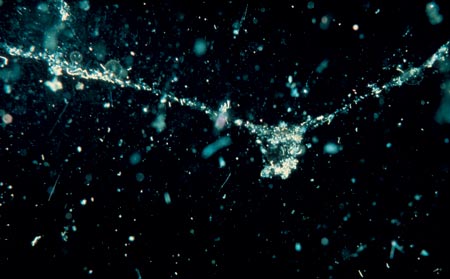Wednesday, September 22, 2010
September 22, 2010 : Marine Snow
Marine Snow
In the deep ocean, marine snow is a continuous shower of mostly organic detritus falling from the upper layers of the water column. Its origin lies in activities within the productive photic zone. Consequently, the prevalence of marine snow changes with seasonal fluctuations in photosynthetic activity and ocean currents. Thus marine snow is heavier in spring, and the reproductive cycles of some deep-sea animals are synchronized to take advantage of this occurence.
Marine snow has a composition which includes: dead or dying animals and plants (plankton), protists (diatoms), fecal matter, sand, soot and other inorganic dust. The "snowflakes" (which are more like clumps or strings) are aggregates of smaller particles held together by a sugary mucus, transparent exopolymer particles (TEPs); natural polymers exuded as waste products by bacteria and phytoplankton. These aggregates grow over time and may reach several centimetres in diameter, travelling for weeks before reaching the ocean floor.
However, most organic components of marine snow are consumed by microbes, zooplankton and other filter-feeding animals within the first 1,000 metres of their journey. In this way marine snow may be considered the foundation of deep-sea mesopelagic and benthic ecosystems: As sunlight cannot reach them, deep-sea organisms rely heavily on marine snow as an energy source. The small percentage of material not consumed in shallower waters becomes incorporated into the muddy "ooze" blanketing the ocean floor, where it is further decomposed through biological activity.
Subscribe to:
Post Comments (Atom)


No comments:
Post a Comment